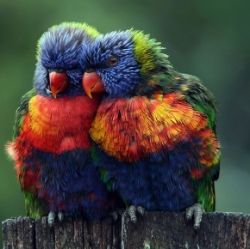Science and Symbolism of Lovebirds

There are nine different species of lovebirds found throughout the African region. All species of this tiny bird range are anywhere from 5 to 7 inches (13 to 19 cm) long and weigh approximately 1.5 to 2.5 ounces (40 to 70 grams). They have a stocky, almost overstuffed quality about them. These colorful flitting birds have blunted tail feathers, miniature cat-claw like hooked beaks, and a natural demeanor towards affection when in love.
Lineage and Behavior
Lovebirds are members of the genus Agapornis and are highly social animals. Their preferred habitat is nesting in outlying forest areas, where flock sizes greatly vary, and their life expectancy is about 15 years. Most all lovebirds mate for life and have a tendency to display erratic behavior once a mate dies. While coupled, it is common for the pair to synchronize their mannerisms and stay within close proximity of each other, only leaving the side of the other to collect food or nesting materials. When coupled, one of the more endearing traits to all lovebird species is the desire to feed each other. They take great care to ensure their mate enjoys a balanced diet of seeds, nuts, fruits, and vegetables.

Common and Scientific Names
Animals that are dimorphic in appearance are those whose gender displays different characteristic attributes. One of the most common examples of dimorphic differences is the majestic plumage of the peacock. The long feathers are a trait that identifies the male peafowl. For lovebirds, it is a matter of color placement. Those that share this trait are the Abyssinian, Madagascar, and Red-Faced lovebirds. The remainders are monomorphic, which means there are little to no discernible differences between the genders. The easiest tell between the genders of monomorphic lovebirds is their size, as the male tends to be slightly smaller than females.
Impact on Human Culture
Geoffrey Chauncer first depicted the comparison between romantic human love and the mating lifestyle of lovebirds in his fictional work Parlement of Foules (1382), which is believed to be the springboard for the Valentine's Day holiday. Amongst scholars, this work is seen as largely responsible for the February 14th holiday date because of the expansive social misinterpretation of the liturgical calendar over the centuries. It is believed that the holiday was originally observed on May 2nd prior to the rise in its mid-February popularity. Regardless of the celebration date, a key constant to the celebration of love is how humans strive to embody the spirit of adoration that lovebirds routinely express to each other.
This is Deb Duxbury, for Animal Life, reminding you to please spay or neuter your pet.
Lineage and Behavior
Lovebirds are members of the genus Agapornis and are highly social animals. Their preferred habitat is nesting in outlying forest areas, where flock sizes greatly vary, and their life expectancy is about 15 years. Most all lovebirds mate for life and have a tendency to display erratic behavior once a mate dies. While coupled, it is common for the pair to synchronize their mannerisms and stay within close proximity of each other, only leaving the side of the other to collect food or nesting materials. When coupled, one of the more endearing traits to all lovebird species is the desire to feed each other. They take great care to ensure their mate enjoys a balanced diet of seeds, nuts, fruits, and vegetables.

Common and Scientific Names
- Abyssinian Lovebird or Agapornis taranta
- Black-checked Lovebird or Agapornis nigrigenis
- Fischer's Lovebird or Agapornis fischeri
- Madagascar Lovebird or Agapornis cana
- Masked Lovebird or Agapornis personata
- Nyasa Lovebird or Agapornis lilianae
- Peach-faced Lovebird or Agapornis roseicollis
- Red-Faced Lovebird or Agapornis pullaria
- Swindern's Lovebird or Agapornis swinderniana
Animals that are dimorphic in appearance are those whose gender displays different characteristic attributes. One of the most common examples of dimorphic differences is the majestic plumage of the peacock. The long feathers are a trait that identifies the male peafowl. For lovebirds, it is a matter of color placement. Those that share this trait are the Abyssinian, Madagascar, and Red-Faced lovebirds. The remainders are monomorphic, which means there are little to no discernible differences between the genders. The easiest tell between the genders of monomorphic lovebirds is their size, as the male tends to be slightly smaller than females.
Impact on Human Culture
Geoffrey Chauncer first depicted the comparison between romantic human love and the mating lifestyle of lovebirds in his fictional work Parlement of Foules (1382), which is believed to be the springboard for the Valentine's Day holiday. Amongst scholars, this work is seen as largely responsible for the February 14th holiday date because of the expansive social misinterpretation of the liturgical calendar over the centuries. It is believed that the holiday was originally observed on May 2nd prior to the rise in its mid-February popularity. Regardless of the celebration date, a key constant to the celebration of love is how humans strive to embody the spirit of adoration that lovebirds routinely express to each other.
This is Deb Duxbury, for Animal Life, reminding you to please spay or neuter your pet.
You Should Also Read:
Feather Weave for Hair is Fowl
Animal Deaths are Rubbish
Volunteer to Conduct Seabird Surveys

Related Articles
Editor's Picks Articles
Top Ten Articles
Previous Features
Site Map
Follow @WildlifeWelfare
Tweet
Content copyright © 2023 by Deb Duxbury. All rights reserved.
This content was written by Deb Duxbury. If you wish to use this content in any manner, you need written permission. Contact Deb Duxbury for details.







